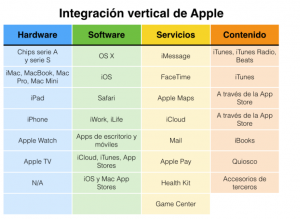INTEGRACIÓN VERTICAL
Acelera tu empresa con estos consejos de expertos que cuenta sobre «Integración vertical». ¡Analiza y descubre esta TIP!
La integración vertical es una estrategia empresarial en la que una empresa asume el control de más de un proceso en la cadena de producción o distribución de sus productos o servicios. Esta estrategia se divide en dos tipos: integración hacia adelante e integración hacia atrás. La integración vertical hacia adelante implica que la empresa adquiere el control de los procesos de distribución y ventas de sus productos o servicios. Por ejemplo, si una empresa productora de calzado adquiere una cadena de tiendas de calzado, estaría utilizando la integración vertical hacia adelante.
Por otro lado, la integración vertical hacia atrás implica que la empresa asume el control de los procesos de producción, es decir, adquiere el control de proveedores o fabricantes de materiales o insumos necesarios para su producción. Por ejemplo, si una empresa productora de alimentos adquiere una granja para producir los alimentos que utiliza en su proceso de producción, estaría utilizando la integración vertical hacia atrás.
Ambos tipos de integración vertical pueden tener ventajas para la empresa, como el control de los costos, la mejora de la eficiencia y la calidad de los productos o servicios, y la reducción de los tiempos de espera y los costos de transporte. Sin embargo, también pueden presentar desventajas, como la dependencia de proveedores o clientes internos y la posible pérdida de flexibilidad.
Consejos a un emprendedores para determinar cuál es el grado de integración vertical
Aquí hay algunos consejos para un emprendedor que desee determinar el grado de integración vertical más adecuado para su nueva empresa:
- Evaluar la industria: comprender el panorama competitivo y las tendencias de la industria puede ayudar a determinar si la integración vertical es adecuada para la empresa. Si la industria está altamente fragmentada, la integración vertical puede ofrecer ventajas competitivas.
- Evaluar la cadena de suministro: evaluar la cadena de suministro de la empresa es importante para determinar si la integración vertical es adecuada. Si los proveedores o los canales de distribución son altamente competitivos y fragmentados, puede tener sentido que la empresa integre verticalmente para mejorar la eficiencia.
- Identificar los costos: la integración vertical puede requerir una inversión significativa en infraestructura, personal y tecnología. Por lo tanto, es importante evaluar los costos y los beneficios potenciales de la integración vertical antes de tomar una decisión.
- Evaluar los recursos internos: la capacidad de la empresa para administrar y operar una cadena de suministro integrada verticalmente también debe evaluarse cuidadosamente. Es importante determinar si la empresa cuenta con los recursos y la experiencia necesarios para administrar la integración vertical de manera efectiva.
- Considerar la flexibilidad: la integración vertical puede limitar la flexibilidad de la empresa, lo que puede ser problemático en un entorno empresarial cambiante. Por lo tanto, es importante considerar la flexibilidad de la empresa y su capacidad para adaptarse a los cambios en la industria.
- Evaluar la rentabilidad: la integración vertical debe considerarse como una inversión a largo plazo en lugar de una solución a corto plazo. Por lo tanto, es importante evaluar el potencial de rentabilidad a largo plazo antes de tomar una decisión.
- Consultar a expertos: por último, se recomienda que los emprendedores busquen el consejo de expertos en la industria o consultores para ayudarles a evaluar la viabilidad de la integración vertical y determinar el grado de integración vertical adecuado para su nueva empresa.
En resumen, antes de decidir si la integración vertical es adecuada para su nueva empresa, es importante evaluar la industria, la cadena de suministro, los costos, los recursos internos, la flexibilidad y la rentabilidad, y buscar el consejo de expertos.
Desventajas de la integración vertical para una nueva empresa
Costos adicionales: la integración vertical puede aumentar los costos de producción, ya que la empresa tendrá que invertir en infraestructura, equipos y recursos adicionales para llevar a cabo las tareas que antes se subcontrataban (+).
- Falta de flexibilidad: la integración vertical puede limitar la capacidad de la empresa para adaptarse a los cambios del mercado, ya que se vuelve más difícil cambiar la producción o los procesos cuando se controlan internamente.
- Riesgo de obsolescencia: la inversión en tecnología y equipos necesarios para la integración vertical puede resultar en activos obsoletos o poco utilizados en el futuro.
- Responsabilidad adicional: la integración vertical puede aumentar la responsabilidad de la empresa en áreas que antes eran manejadas por terceros, como la seguridad y las regulaciones.
- Posibles conflictos de interés: la integración vertical puede crear posibles conflictos de interés, ya que la empresa puede favorecer sus propias operaciones internas en lugar de buscar lo mejor para sus clientes o proveedores.
Las razones de la integración vertical se resumen en:
- Mayores economías de alcance. Derivadas de un mejor aprovechamiento de los recursos que pueden ser compartidos.
- Reducción de procesos intermedios. Por ejemplo, logística.
- Reducción de costes de transacción.
- Obtención de mayores márgenes y con ello de una mejor rentabilidad del negocio.
Un caso especialmente destacado de integración vertical es el ejercido por Apple, que se encarga de gran parte (casi totalidad) de los pasos para ofrecer sus productos. Diseña, produce los componentes electrónicos, los ensambla en sus fábricas, los promociona en sus canales de comunicación y los distribuye en sus propios establecimientos. Existen multitud de ejemplos en la economía en los que la integración vertical es una herramienta de éxito para empresas, como las compañías petrolíferas que extraen, procesan, distribuyen y comercializan gasóleos.

APLICA ESTE TIP EN TU PROYECTO
QUIZ
- 💻 PRACTICA con un experto en el próximo webinar práctico.
- 🔎 CONSULTA más TIPs relacionadas con este mismo tema.
- 📖 AMPLIA tus conocimientos descargando este EBOOK.
PIENSA EN TI
- 🚀 IMPULSA tu empresa en el próximo programa de aceleración, ¡reserva tu plaza ya!
- 🥁 PRACTICA con tu proyecto en este webinar práctico, ¡solicita tu plaza!.
- 🌐 CONTACTA con otros emprendedores y empresas, ¡inscríbete y participa en el próximo Networking!
PIENSA EN AYUDAR A LOS DEMÁS
- 🤝COLABORA como voluntario: experto, mentor, inversor, premiando, difundiendo, retando, innovando, creando una TIP…
- 💬 RECOMIENDA este programa para que llegue a más emprendedores por Google.
- 👉 ¡COMPARTE tu aprendizaje!
- 📲 REENVÍA esta TIP 👇









